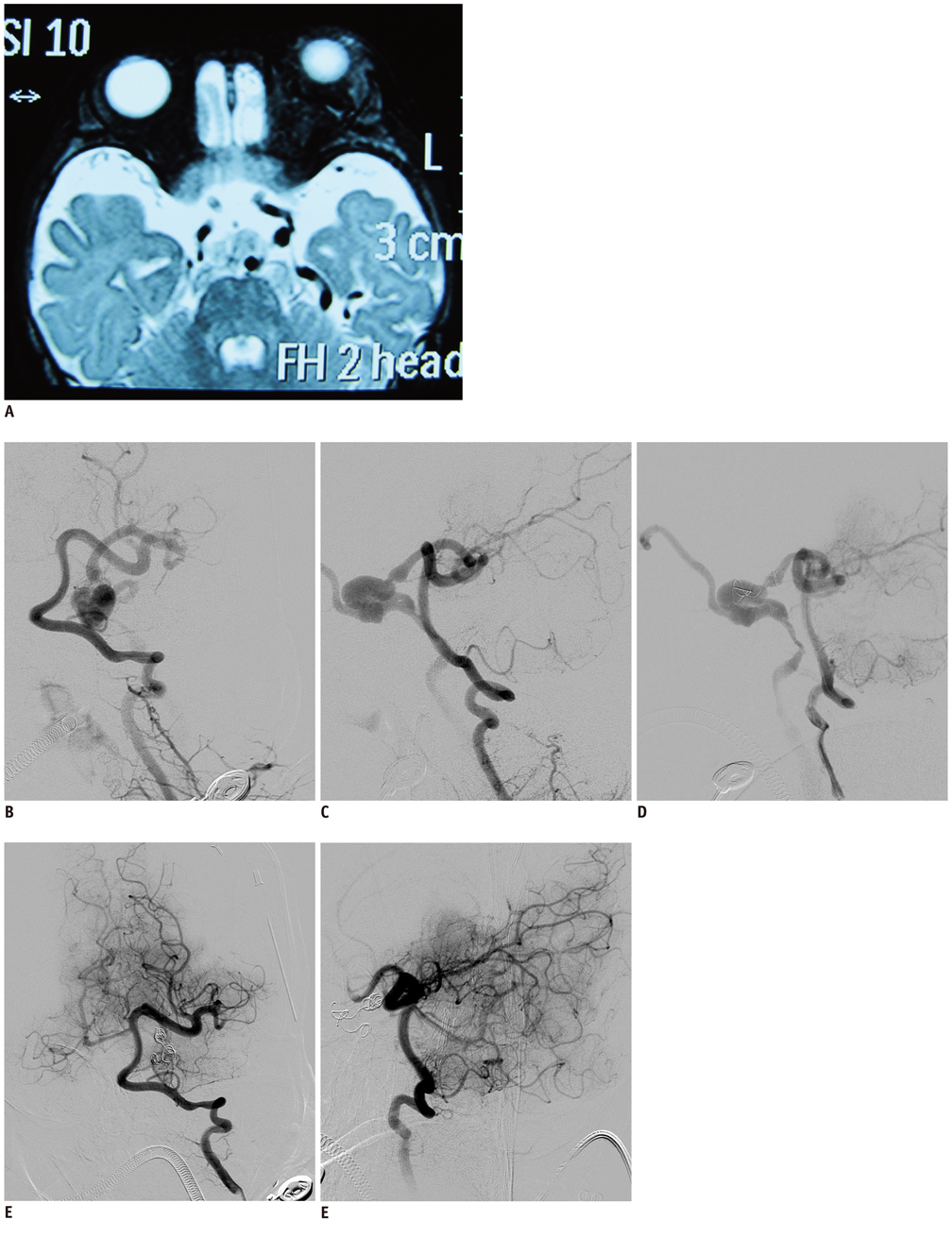Korean J Radiol.
2013 Jun;14(3):497-500. 10.3348/kjr.2013.14.3.497.
Congenital Pial Arteriovenous Fistula in the Temporal Region Draining into Cavernous Sinus: A Case Report
- Affiliations
-
- 1Department of Neurosurgery, West China Hospital of Sichuan University, Chengdu, Sichuan Province, 610041, China. xiaodong_1962@163.com
- 2Department of Neurosurgery, Affiliated Hospital of Hainan Medical College, Haikou, Hainan Province, 570102, China.
- KMID: 1705466
- DOI: http://doi.org/10.3348/kjr.2013.14.3.497
Abstract
- This report concerns a 4-month-old infant with progressive prominent and redness of his left eye since birth. This report concerns a 4-month-old infant with progressive prominent redness of his left eye since birth. Angiography revealed a congenital pial arteriovenous fistula between the temporal branch of the left posterior cerebral artery and left cavernous sinus through the sphenoparietal sinus, a condition not reported in the literature. The fistula was successfully occluded with two micro-coils by vertebrobasilar approach.
MeSH Terms
Figure
Reference
-
1. Halbach VV, Higashida RT, Hieshima GB, Norman D. Normal perfusion pressure breakthrough occurring during treatment of carotid and vertebral fistulas. AJNR Am J Neuroradiol. 1987. 8:751–756.2. Hoh BL, Putman CM, Budzik RF, Ogilvy CS. Surgical and endovascular flow disconnection of intracranial pial single-channel arteriovenous fistulae. Neurosurgery. 2001. 49:1351–1363. discussion 1363-1364.3. Oka K, Rhoton AL Jr, Barry M, Rodriguez R. Microsurgical anatomy of the superficial veins of the cerebrum. Neurosurgery. 1985. 17:711–748.4. Amaral FT, Machado HR, Almeida S. [Congenital cerebral arteriovenous fistula. Diagnostic peculiarity and surgical repair in an infant with heart failure]. Arq Bras Cardiol. 1994. 63:207–209.5. Haase J. Congestive heart failure secondary to cerebral arteriovenous fistula. Childs Nerv Syst. 1988. 4:75.6. Berant M, Tadmor R, Blieden L, Deutsch V, Neufeld HN. Cerebral arteriovenous fistula causing congestive heart failure in infancy. Angiology. 1977. 28:684–686.7. Sasamori T, Hida K, Yano S, Asano T, Iwasaki Y. Cervical perimedullary arteriovenous fistula in an infant presenting with subarachnoid hemorrhage--case report. Neurol Med Chir (Tokyo). 2008. 48:409–413.8. Lee JY, Son YJ, Kim JE. Intracranial pial arteriovenous fistulas. J Korean Neurosurg Soc. 2008. 44:101–104.9. Nelson K, Nimi Y, Lasjaunias P, Berenstein A. Endovascular embolization of congenital intracranial pial arteriovenous fistulas. Neuroimaging Clin N Am. 1992. 2:309–317.10. Paramasivam S, Toma N, Niimi Y, Berenstein A. De novo development of dural arteriovenous fistula after endovascular embolization of pial arteriovenous fistula. J Neurointerv Surg. 2012. [Epub ahead of print].11. Rivera R, Blanc R, Piotin M, Spelle L, Moret J. Single hole cerebral arteriovenous fistula between the anterior choroidal artery and the basal vein of Rosenthal in a child. Childs Nerv Syst. 2009. 25:1521–1523.
- Full Text Links
- Actions
-
Cited
- CITED
-
- Close
- Share
- Similar articles
-
- Embolization of Cerebral Pial Arteriovenous Fistula Under Balloon-assisted Flow Control Using NBCA: a Case Report
- Congenital Intracranial Pial Arteriovenous Fistula Complicated with Congestive Heart Failure in Neonate: A Case Report
- Successful Treatment of Intracranial Small Pial Single-Channel Arteriovenous Fistula Using N-butyl Cyanoacrylate: Report of 2 Cases
- Middle temporal vein access for transvenous embolization of Cavernous sinus dural arteriovenous fistula: A case report and review of literature
- Transvenous Embolization of Cavernous Sinus Dural Arteriovenous Fistula Using the Direct Superior Ophthalmic Vein Approach: A Case Report


